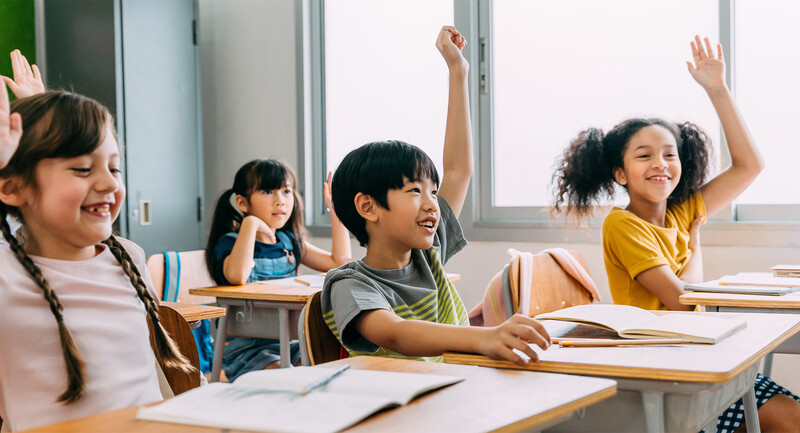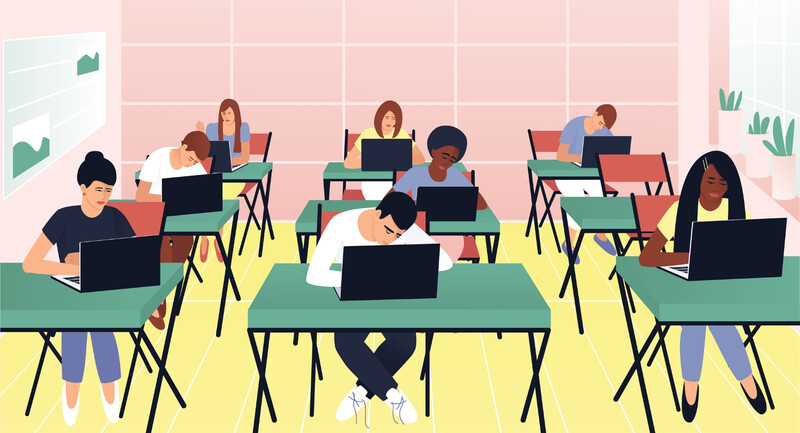Since schools first shuttered in March 2020, researchers and educators alike have recognized the negative effects of the COVID-19 pandemic on student learning. But data released this summer captures a potential shift in that narrative, and some reasons for hope, albeit with caveats.
A July research brief published by the nonprofit assessment company NWEA found initial signs of rebounding in academic gains for students in many grades during the 2021-22 school year. These gains paralleled pre-pandemic trends and applied to both high- and low-poverty schools.
The NWEA research team emphasized that student achievement was still lower in the 2021-22 school year than in pre-pandemic years—especially for Black, Latino, and Indigenous students and students in high-poverty schools—and a full recovery to pre-pandemic achievement is, in many cases, still years away. In other words, many students are now beginning to make up for the learning they lost during the pandemic, but they still have a long way to go before they return to pre-pandemic achievement. Even so, the indicators that students are improving academically at the same rate, or sometimes faster, than they were before the pandemic are important considering the steep decline in achievement many students experienced over the past 2.5 years.
“Yes, we still have [achievement] gaps. But the good news is that the gains we're seeing have returned to pre-pandemic averages,” said Karyn Lewis, director of the Center for School and Student Progress at NWEA and one of the study’s co-authors. “It will take above-average growth to get us out of those gaps. But the bright spot is that [achievement] gains are starting to look more similar to pre-pandemic trends.”
Tracing Student Rebounds
NWEA researchers analyzed data from math and reading MAP Growth assessments, which the organization develops, for 3rd to 8th graders. They studied year-over-year changes in these test scores during two four-year periods: 2015-16 through 2018-19 and 2018-19 through 2021-22 (capturing the full extent of the pandemic so far). Schools can participate in MAP Growth assessments up to four times a year, but the research team focused specifically on the results of fall and spring assessments.
These data show a downturn in student scores during the pandemic, when compared to pre-pandemic years. For example, 4th graders in the spring of 2021 scored on average 13 points lower in reading and 28 points lower in math than 4th graders in the spring of 2017. However, in the spring of 2022, 5th graders scored only 10 points lower in reading and 22 points lower in math than their counterparts in 2018, meaning that these students are beginning to recover some of the learning they lost during the pandemic.
“We've pulled out of that nosedive and returned to this level of stasis,” said Lewis. “That's the good news, but we've already lost so much altitude, just returning to stasis is going to keep us at this lower level of achievement. We need to have above-average gains to make up those gaps.”
Using these data, researchers also sought to map out how long it would take for student achievement to recover to pre-pandemic levels, if current trends continue. In some cases, that outcome doesn’t look far off. For example, 4th graders in the spring of 2022 may only need one to two more years for their reading MAP achievement scores to align with pre-pandemic levels. In math, it may take them three to five more years.
On the other hand, some student cohorts haven’t demonstrated the same rebound in their reading or math scores, and the achievement gap between their current test scores and pre-pandemic scores for the equivalent grade level may have even widened. Seventh and 8th graders in the spring of 2022, for example, are not yet on track to rebound to pre-pandemic reading and math scores within five years. Generally, students in lower grades demonstrated stronger year-over-year improvement and a faster path back to pre-pandemic achievement.
Student and School Demographics
Notably, the rebounds in achievement gains applied to schools across poverty levels. Achievement gaps between 5th graders in the spring of 2022 and their pre-pandemic counterparts, for example, were smaller than the equivalent gaps for 4th graders a year earlier, in both high- and low-poverty schools. However, there’s an important caveat: students in high-poverty schools lost more ground during the pandemic and continue to average significantly lower scores in both reading and math than their peers in low-poverty schools.
“It's going to take a longer period of time for [students in high-poverty schools] to get back to where they would have been absent the pandemic, which is already well below those kids in low-poverty schools,” said Lewis.
The findings also demonstrate that Black, Latino, and Indigenous students saw bigger decreases in achievement than white and Asian students during the pandemic. The differences in achievement loss across race were most evident in younger grades.
What to Make of MAP Data
The report’s use of MAP Growth assessments is notable; other news-making studies have also analyzed the data from these standardized tests to draw conclusions about student learning during the pandemic. Interpreting results from this kind of assessment, however, has met criticism from some educators and researchers who argue that test scores alone provide a limited view of how students fared during the turbulence of the past few years and can fuel an overfocus on academic remediation at the expense of support for well-being and intellectual engagement.
The concern for students’ social-emotional needs, even at a time of heightened academic needs, is palpable for many teachers. In a July survey by Khan Academy that asked teachers what could help students make up learning gaps, 60 percent responded with “increasing emotional/behavioral support.”
The NWEA’s Lewis recognizes that assessment data alone cannot provide a complete picture of student learning. The challenges students faced reacclimating to the classroom and rebuilding relationships with their teachers and peers are critical pieces of any conversation about the pandemic’s impact on learning, she said. However, she argues the limited view test scores provide do have value as one snapshot of not only how students struggled, but also how they overcame obstacles.
“We have information about one very small, limited scope of kids’ experience . . . . But it also offers a picture of the way kids have really been resilient over the last few years and found . . . other ways of succeeding when perhaps they were denied the instruction that they would have expected if there had not been a pandemic,” said Lewis.
The current attention on making up lost ground in achievement may also pay longer-term dividends: If schools can recover from the damaging effects of the pandemic, they may be able to begin reversing the much deeper educational inequities we faced long before COVID-19.
“If we want to look for a bright spot here, my hope is that we're learning some new best practices about how to get kids back on track and how to accelerate their learning,” said Lewis. “So, the question to me is, why stop at a pre-pandemic status quo?”








